Abstract
OBJECTIVE: The objective of this study was to determine the trend of breast conservation surgery (BCS) in North Carolina over a 6-year period and to identify patient, hospital, and surgeon factors associated with the use of BCS. SUMMARY BACKGROUND DATA: Despite evidence that BCS is an appropriate method of treatment for early stage breast cancer, surgeons in the United States have been slow to adopt this treatment method. METHODS: Cases of primary breast cancer surgery in all 157 hospitals in the state from 1988 to 1993, inclusive (N = 20,760), were obtained from the State Medical Database Commission, Area Resource File, American Hospital Association and State Board of Medical Examiner's Databases. Multiple logistic regression was used to generate odds ratios (ORs) and 95% confidence intervals (CIs) to determine factors associated with BCS. RESULTS: The rate of BCS doubled from 7.3% in 1988 to 14.3% in 1993, with an overall rate of 10.2% (2117/ 20.760). Multiple logistic regression identified the following factors associated with BCS: patient age younger than 50 years of age (OR = 1.7, 95% CI = 1.4, 2.1), patient age 50 to 69 years of age (OR = 1.2, 95% CI = 1.1, 1.4), private insurance (OR = 1.2, 95% CI = 1.0, 1.4), hospital bed size 401+(OR = 2.0, 95% CI = 1.6, 2.5), bed size 101 to 400 (OR = 1.7, 95% CI = 1.3, 2.1), and surgeon graduation from medical school since 1981 (OR = 1.6, 95% CI = 1.2, 2.0). CONCLUSIONS: Rates of BCS in North Carolina are low. Least likely to have BCS were women older than 70 years of age, without private insurance, treated at small hospitals by older surgeons. To increase the use of BCS, widespread education of surgeons, other health care providers, policy makers, and the general public is warranted.
Full text
PDF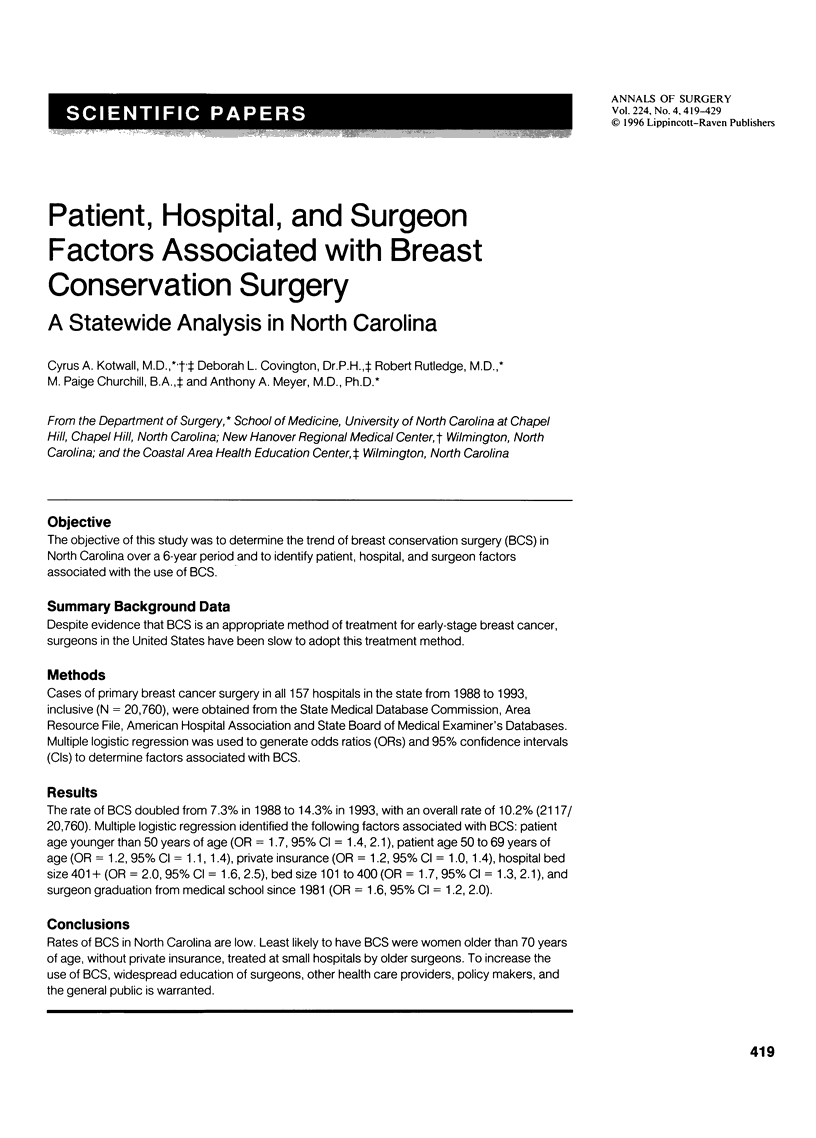
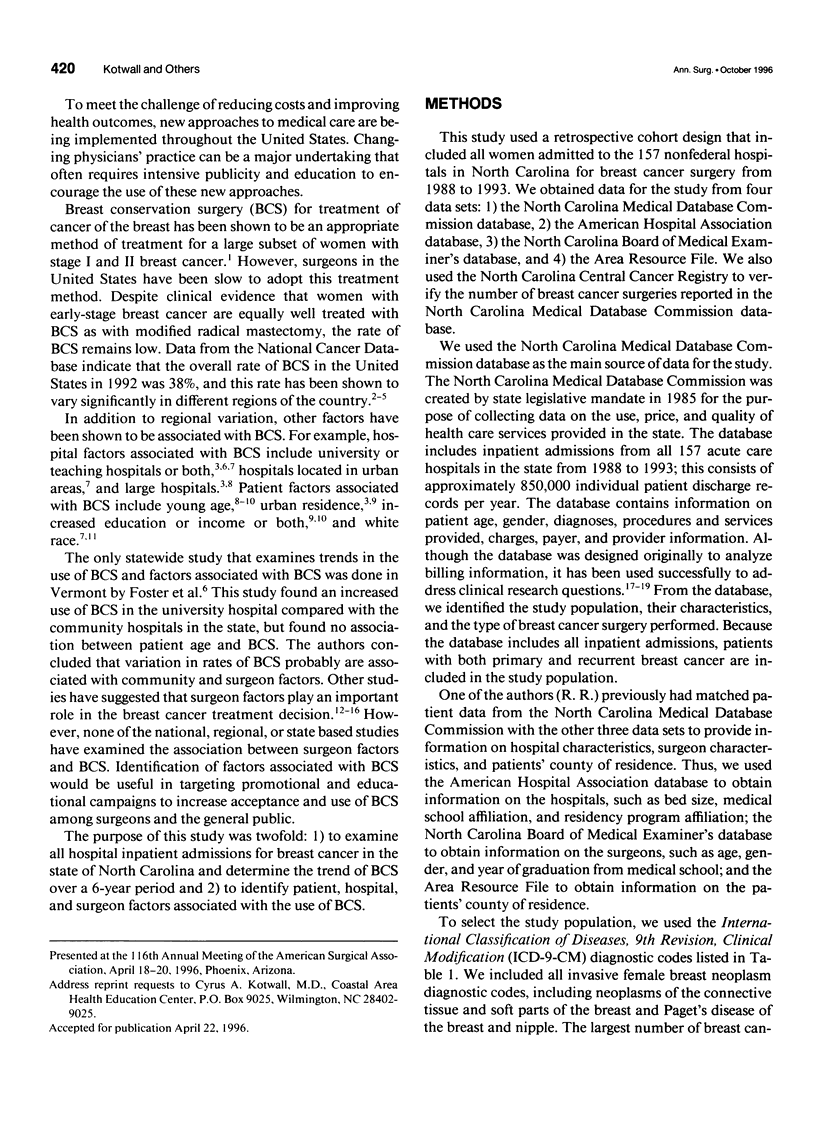
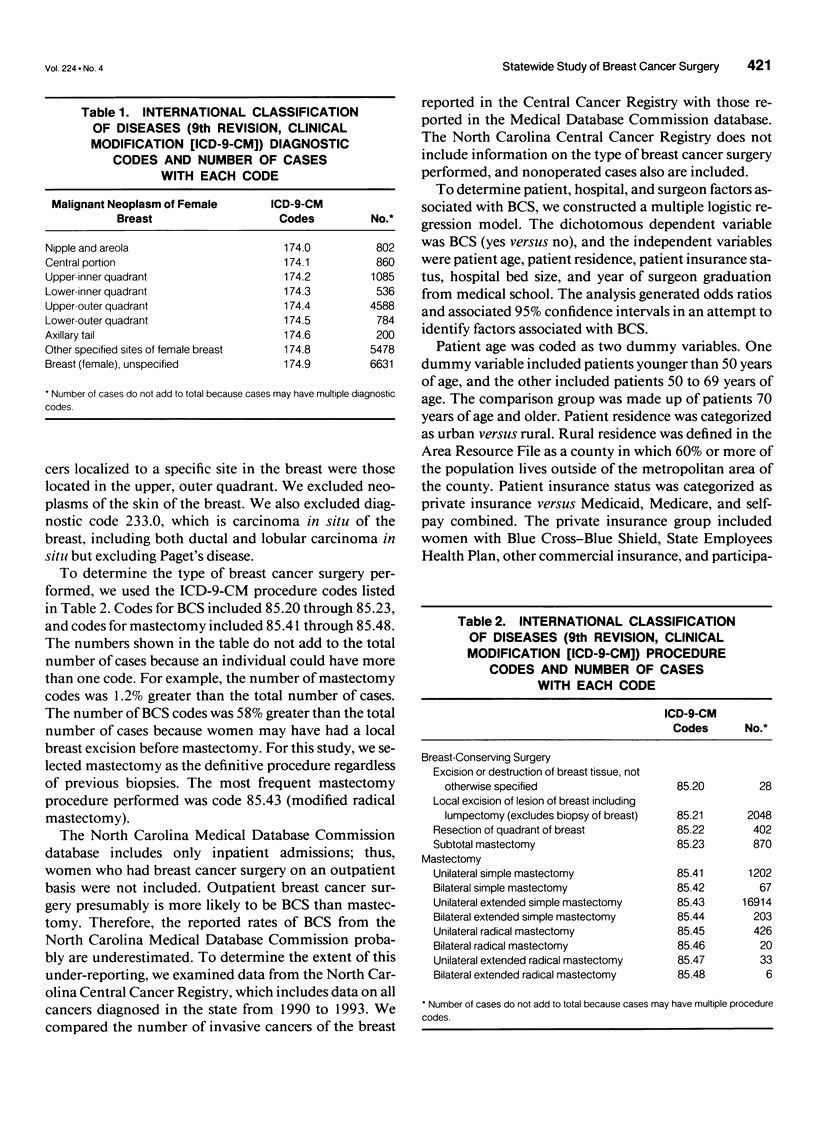
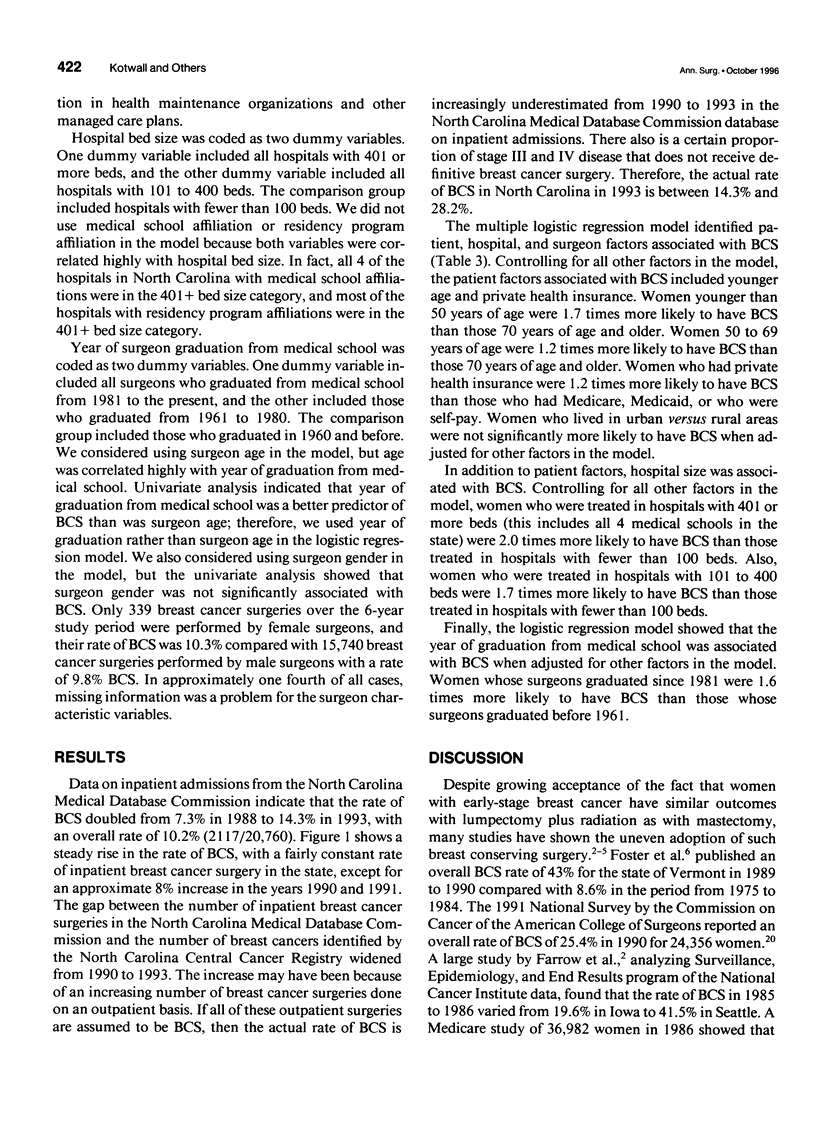
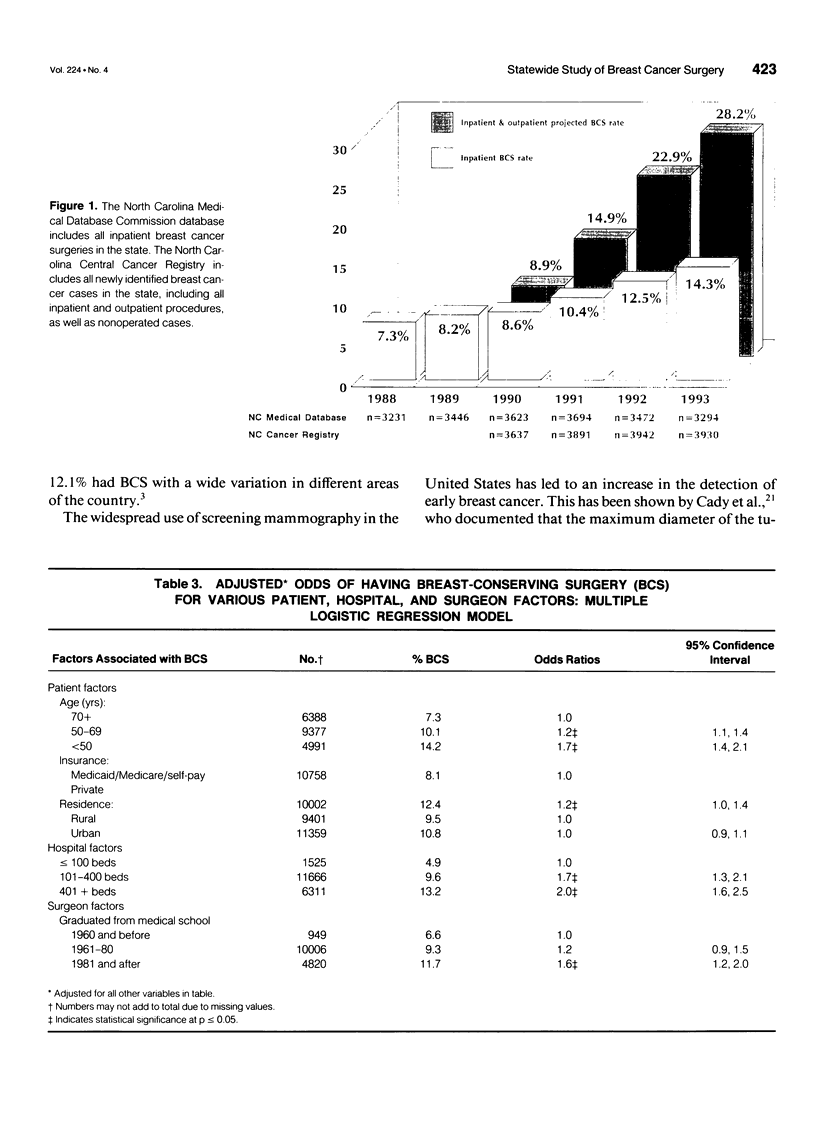
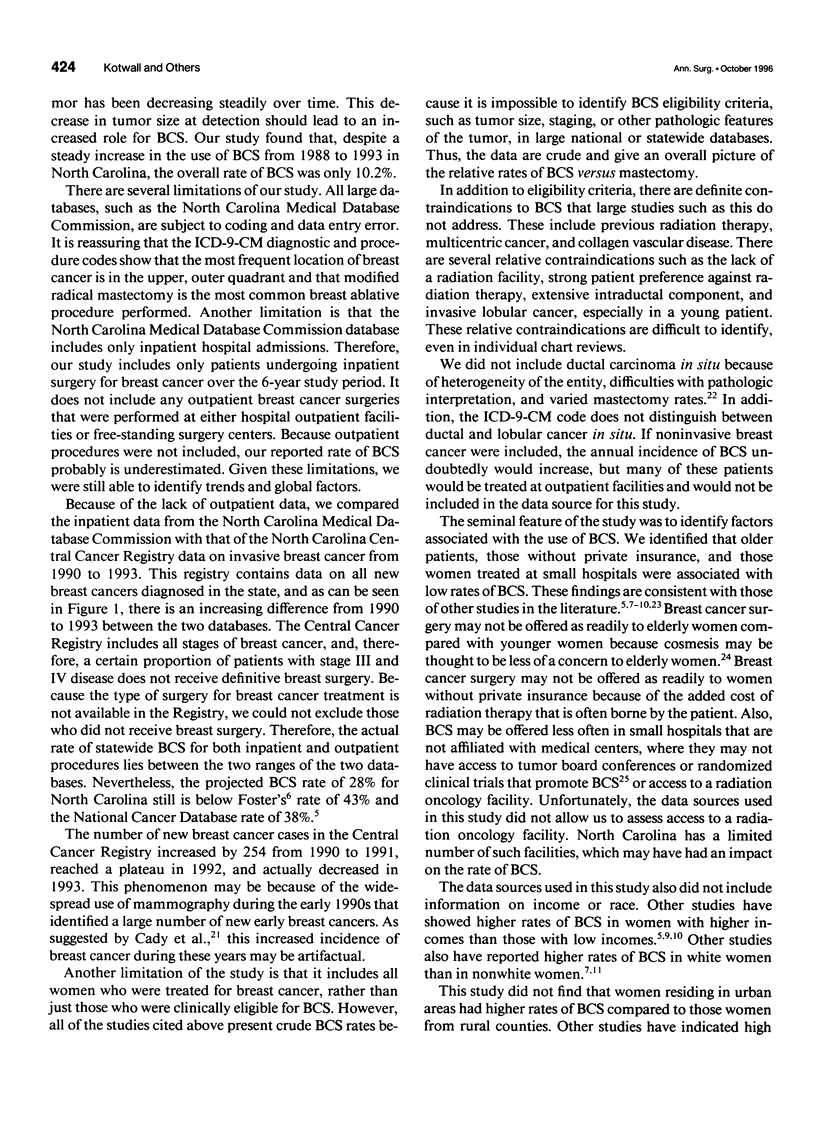
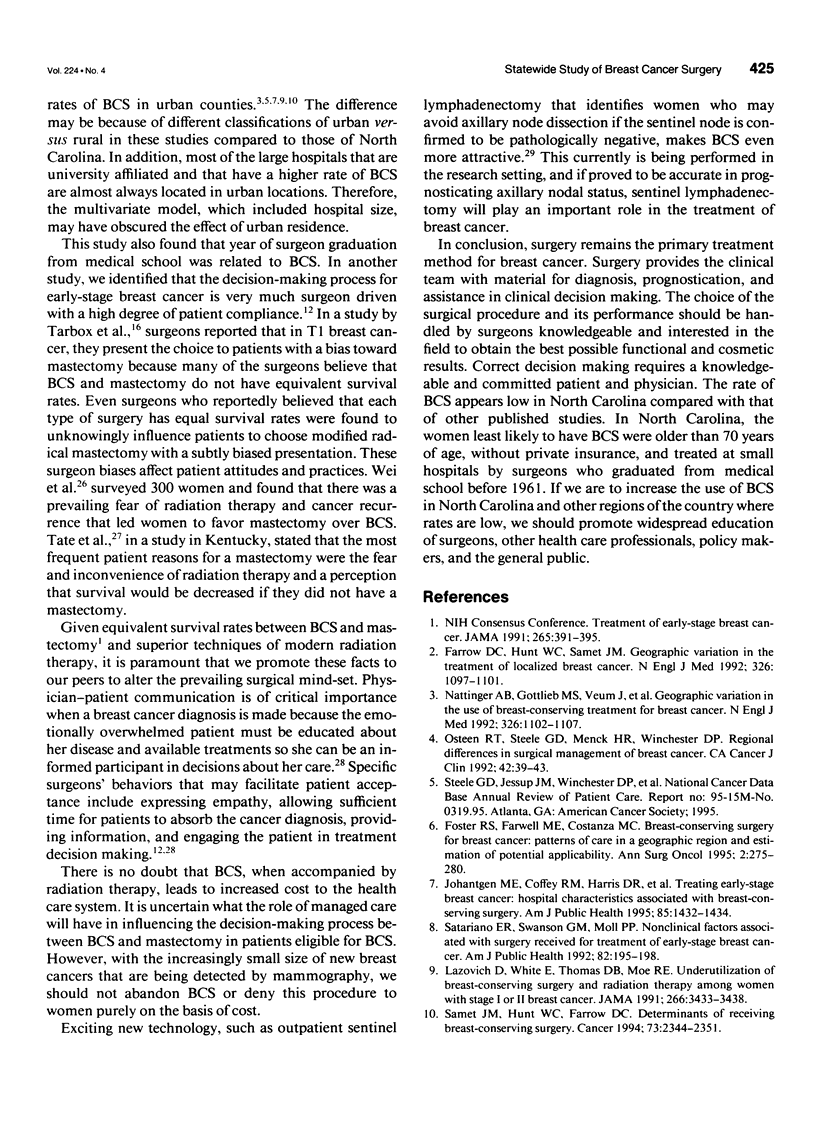
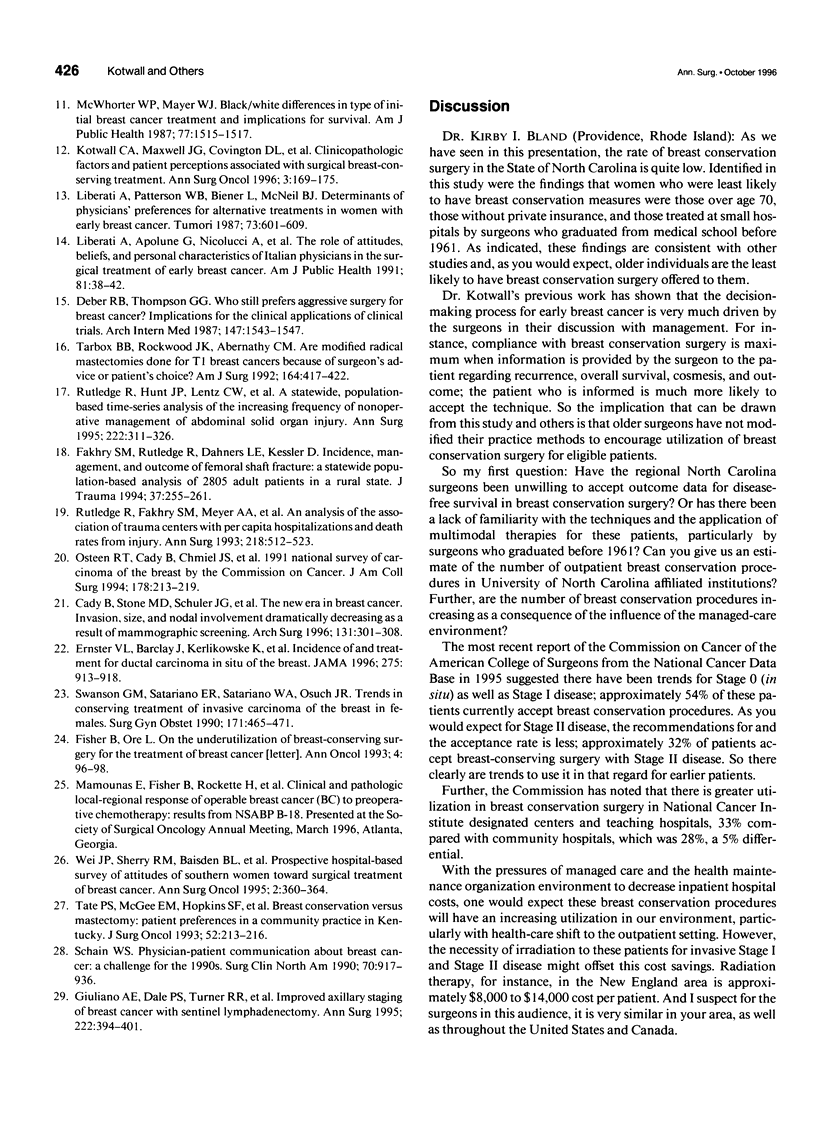
Images in this article
Selected References
These references are in PubMed. This may not be the complete list of references from this article.
- Cady B., Stone M. D., Schuler J. G., Thakur R., Wanner M. A., Lavin P. T. The new era in breast cancer. Invasion, size, and nodal involvement dramatically decreasing as a result of mammographic screening. Arch Surg. 1996 Mar;131(3):301–308. doi: 10.1001/archsurg.1996.01430150079015. [DOI] [PubMed] [Google Scholar]
- Deber R. B., Thompson G. G. Who still prefers aggressive surgery for breast cancer? Implications for the clinical applications of clinical trials. Arch Intern Med. 1987 Sep;147(9):1543–1547. [PubMed] [Google Scholar]
- Ernster V. L., Barclay J., Kerlikowske K., Grady D., Henderson C. Incidence of and treatment for ductal carcinoma in situ of the breast. JAMA. 1996 Mar 27;275(12):913–918. [PubMed] [Google Scholar]
- Fakhry S. M., Rutledge R., Dahners L. E., Kessler D. Incidence, management, and outcome of femoral shaft fracture: a statewide population-based analysis of 2805 adult patients in a rural state. J Trauma. 1994 Aug;37(2):255–261. [PubMed] [Google Scholar]
- Farrow D. C., Hunt W. C., Samet J. M. Geographic variation in the treatment of localized breast cancer. N Engl J Med. 1992 Apr 23;326(17):1097–1101. doi: 10.1056/NEJM199204233261701. [DOI] [PubMed] [Google Scholar]
- Fisher B., Ore L. On the underutilization of breast-conserving surgery for the treatment of breast cancer. Ann Oncol. 1993 Feb;4(2):96–98. doi: 10.1093/oxfordjournals.annonc.a058444. [DOI] [PubMed] [Google Scholar]
- Foster R. S., Jr, Farwell M. E., Costanza M. C. Breast-conserving surgery for breast cancer: patterns of care in a geographic region and estimation of potential applicability. Ann Surg Oncol. 1995 May;2(3):275–280. doi: 10.1007/BF02307035. [DOI] [PubMed] [Google Scholar]
- Giuliano A. E., Dale P. S., Turner R. R., Morton D. L., Evans S. W., Krasne D. L. Improved axillary staging of breast cancer with sentinel lymphadenectomy. Ann Surg. 1995 Sep;222(3):394–401. doi: 10.1097/00000658-199509000-00016. [DOI] [PMC free article] [PubMed] [Google Scholar]
- Johantgen M. E., Coffey R. M., Harris D. R., Levy H., Clinton J. J. Treating early-stage breast cancer: hospital characteristics associated with breast-conserving surgery. Am J Public Health. 1995 Oct;85(10):1432–1434. doi: 10.2105/ajph.85.10.1432. [DOI] [PMC free article] [PubMed] [Google Scholar]
- Kotwall C. A., Maxwell J. G., Covington D. L., Churchill P., Smith S. E., Covan E. K. Clinicopathologic factors and patient perceptions associated with surgical breast-conserving treatment. Ann Surg Oncol. 1996 Mar;3(2):169–175. doi: 10.1007/BF02305797. [DOI] [PubMed] [Google Scholar]
- Lazovich D. A., White E., Thomas D. B., Moe R. E. Underutilization of breast-conserving surgery and radiation therapy among women with stage I or II breast cancer. JAMA. 1991 Dec 25;266(24):3433–3438. [PubMed] [Google Scholar]
- Liberati A., Apolone G., Nicolucci A., Confalonieri C., Fossati R., Grilli R., Torri V., Mosconi P., Alexanian A. The role of attitudes, beliefs, and personal characteristics of Italian physicians in the surgical treatment of early breast cancer. Am J Public Health. 1991 Jan;81(1):38–42. doi: 10.2105/ajph.81.1.38. [DOI] [PMC free article] [PubMed] [Google Scholar]
- Liberati A., Patterson W. B., Biener L., McNeil B. J. Determinants of physicians' preferences for alternative treatments in women with early breast cancer. Tumori. 1987 Dec 31;73(6):601–609. doi: 10.1177/030089168707300609. [DOI] [PubMed] [Google Scholar]
- McWhorter W. P., Mayer W. J. Black/white differences in type of initial breast cancer treatment and implications for survival. Am J Public Health. 1987 Dec;77(12):1515–1517. doi: 10.2105/ajph.77.12.1515. [DOI] [PMC free article] [PubMed] [Google Scholar]
- Nattinger A. B., Gottlieb M. S., Veum J., Yahnke D., Goodwin J. S. Geographic variation in the use of breast-conserving treatment for breast cancer. N Engl J Med. 1992 Apr 23;326(17):1102–1107. doi: 10.1056/NEJM199204233261702. [DOI] [PubMed] [Google Scholar]
- Osteen R. T., Cady B., Chmiel J. S., Clive R. E., Doggett R. L., Friedman M. A., Hussey D. H., Kraybill W. G., Urist M. M., Winchester D. P. 1991 national survey of carcinoma of the breast by the Commission on Cancer. J Am Coll Surg. 1994 Mar;178(3):213–219. [PubMed] [Google Scholar]
- Osteen R. T., Steele G. D., Jr, Menck H. R., Winchester D. P. Regional differences in surgical management of breast cancer. CA Cancer J Clin. 1992 Jan-Feb;42(1):39–43. doi: 10.3322/canjclin.42.1.39. [DOI] [PubMed] [Google Scholar]
- Rutledge R., Fakhry S. M., Meyer A., Sheldon G. F., Baker C. C. An analysis of the association of trauma centers with per capita hospitalizations and death rates from injury. Ann Surg. 1993 Oct;218(4):512–524. doi: 10.1097/00000658-199310000-00011. [DOI] [PMC free article] [PubMed] [Google Scholar]
- Rutledge R., Hunt J. P., Lentz C. W., Fakhry S. M., Meyer A. A., Baker C. C., Sheldon G. F. A statewide, population-based time-series analysis of the increasing frequency of nonoperative management of abdominal solid organ injury. Ann Surg. 1995 Sep;222(3):311–326. doi: 10.1097/00000658-199509000-00009. [DOI] [PMC free article] [PubMed] [Google Scholar]
- Samet J. M., Hunt W. C., Farrow D. C. Determinants of receiving breast-conserving surgery. The Surveillance, Epidemiology, and End Results Program, 1983-1986. Cancer. 1994 May 1;73(9):2344–2351. doi: 10.1002/1097-0142(19940501)73:9<2344::aid-cncr2820730917>3.0.co;2-v. [DOI] [PubMed] [Google Scholar]
- Satariano E. R., Swanson G. M., Moll P. P. Nonclinical factors associated with surgery received for treatment of early-stage breast cancer. Am J Public Health. 1992 Feb;82(2):195–198. doi: 10.2105/ajph.82.2.195. [DOI] [PMC free article] [PubMed] [Google Scholar]
- Schain W. S. Physician-patient communication about breast cancer. A challenge for the 1990s. Surg Clin North Am. 1990 Aug;70(4):917–936. doi: 10.1016/s0039-6109(16)45189-3. [DOI] [PubMed] [Google Scholar]
- Swanson G. M., Satariano E. R., Satariano W. A., Osuch J. R. Trends in conserving treatment of invasive carcinoma of the breast in females. Surg Gynecol Obstet. 1990 Dec;171(6):465–471. [PubMed] [Google Scholar]
- Tarbox B. B., Rockwood J. K., Abernathy C. M. Are modified radical mastectomies done for T1 breast cancers because of surgeon's advice or patient's choice? Am J Surg. 1992 Nov;164(5):417–422. doi: 10.1016/s0002-9610(05)81172-9. [DOI] [PubMed] [Google Scholar]
- Tate P. S., McGee E. M., Hopkins S. F., Rogers E. L., Page G. V. Breast conservation versus mastectomy: patient preferences in a community practice in Kentucky. J Surg Oncol. 1993 Apr;52(4):213–216. doi: 10.1002/jso.2930520403. [DOI] [PubMed] [Google Scholar]
- Wei J. P., Sherry R. M., Baisden B. L., Peckel J., Lala G. Prospective hospital-based survey of attitudes of Southern women toward surgical treatment of breast cancer. Ann Surg Oncol. 1995 Jul;2(4):360–364. doi: 10.1007/BF02307070. [DOI] [PubMed] [Google Scholar]



